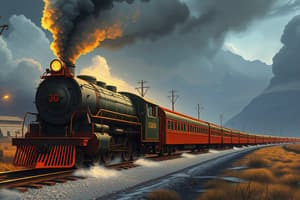Podcast
Questions and Answers
What factors contributed to the industrialization of America?
What factors contributed to the industrialization of America?
Natural resources, immigration, government, entrepreneurs, and inventors.
What factors explained the emergence of large corporations, and what did Americans think of them?
What factors explained the emergence of large corporations, and what did Americans think of them?
Industrial revolution and America's vast number of natural resources.
How did workers respond to the rise of industrialization?
How did workers respond to the rise of industrialization?
They formed unions and other organizations.
What resulted from the clashes between workers and big business during the 1880s and 1890s?
What resulted from the clashes between workers and big business during the 1880s and 1890s?
How did pre-Civil War immigrants differ from those who entered America between 1890 and 1920?
How did pre-Civil War immigrants differ from those who entered America between 1890 and 1920?
What experiences were common to most immigrants who came to America?
What experiences were common to most immigrants who came to America?
What was urban life like for most city residents?
What was urban life like for most city residents?
How did religious leaders appeal to city residents?
How did religious leaders appeal to city residents?
Flashcards are hidden until you start studying
Study Notes
Industrialization of America
- Factors driving industrialization included natural resources, immigration, supportive government policies, entrepreneurs, and inventors.
- Resulted in a rising standard of living, improved transportation, and increased population growth.
Emergence of Large Corporations
- The Industrial Revolution played a crucial role in the rise of large corporations.
- America’s abundant natural resources contributed significantly to corporate growth.
Workers' Response to Industrialization
- Workers formed unions, such as the Knights of Labor, to advocate for their rights and better working conditions.
Clashes between Workers and Big Business
- The 1880s and 1890s witnessed significant tensions between labor and corporations, leading to the establishment of antitrust laws.
- Labor unions gained recognition as a response to workers' struggles against corporate power.
Immigration Patterns Pre- and Post-Civil War
- Immigrants before the Civil War primarily came from Northern and Western Europe.
- Between 1890 and 1920, the influx shifted to Southern and Eastern European immigrants.
Experiences of Immigrants in America
- Many immigrants faced hardships, including low wages and discrimination, as they took on cheap labor jobs.
- Their distinct cultures were often disrespected, leading to social tensions and legislative measures against them.
Urban Life for City Residents
- Overcrowding was a significant issue in urban areas due to rapid population growth and the prevalence of tenement housing among immigrants.
Religious Leaders and City Residents
- The Social Gospel Movement emerged as a response from religious leaders, advocating for improved working conditions and social justice.
Studying That Suits You
Use AI to generate personalized quizzes and flashcards to suit your learning preferences.




